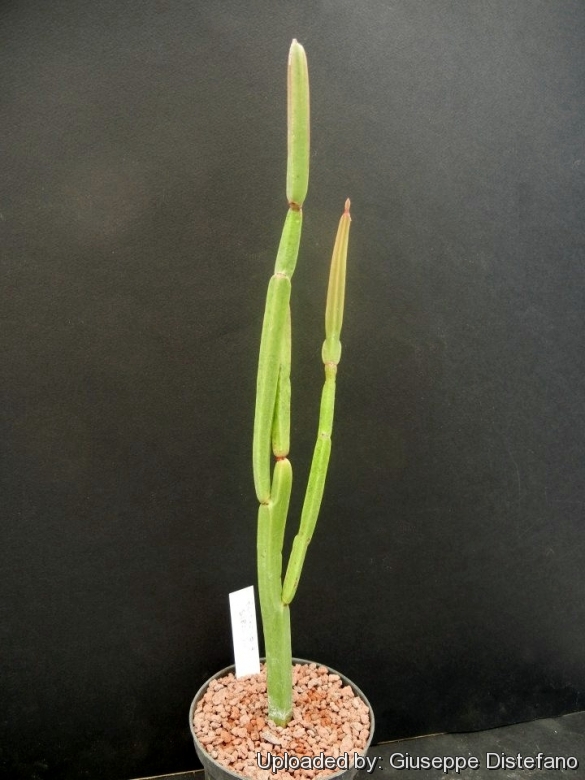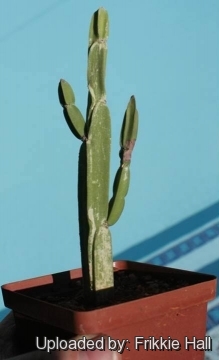




Your support is critical to our success.

Origin and Habitat: Brazil, Minas Gerais.
Habitat: Sandy Campo Rupestre.
Synonyms:
- Euphorbia sipolisii N.E.Br.
Description: Euphorbia sipolisiiSN|27723]]SN|26941]] is a cereiform, succulent shrub from Brazil. It branches profusely at the base from a short stem and above into a multitude of erect green stems, radiating out to form a rounded bush up to1 m high and as much or more in diameter. It similar to Euphorbia pteroneuraSN|26942]]SN|26942]] and Euphorbia phosphoreaSN|26941]]SN|27723]], but stems with 4 rounded ridges and grooved sides. It is uncommon in cultivation except in specialist collections. Flowers dark red and glossy.
Stem (branches): Erect, leafless, about 1 cm thick, constricted into segments. Segments about 10 cm long, sharply 4(or 5 )-angled, somewhat concave, grey-green to brownish-green, somewhat convex at the angles.
Leaves: Very tiny, triangular, acute, soon deciduous.
Flowers (Cyathia): Dark red, about 8 mm in diameter. Nectar glands 2- horned, horns short; Fruits: 3-lobed, 6 x 6 mm, reddish, Peduncle exserted, reflexed.
Seed: Ovoid, 3 mm, with a caruncle.
Bibliography: Major references and further lectures
1) Hermann Jacobsen “Abromeitiella to Euphorbia” Blandford Press, 1960
2) James Cullen, Sabina G. Knees, H. Suzanne Cubey “The European Garden Flora Flowering Plants: A Manual for the Identification of Plants Cultivated in Europe, Both Out-of-Doors and Under Glass” Cambridge University Press, 11/ago/2011
3) Hermann Jacobsen “A handbook of succulent plants: descriptions, synonyms, and cultural details for succulents other than Cactaceae” Volume 1 Blandford Press, 1960
4) Urs Eggli “Illustrated Handbook of Succulent Plants: Dicotyledons” Springer, 2002

Euphorbia sipolisii Photo by: Frikkie Hall
The gallery now contains thousands of pictures, however it is possible to do even more. We are, of course, seeking photos of species not yet shown in the gallery but not only that, we are also looking for better pictures than those already present. Read More...
Cultivation and Propagation: It is an easy species to grow that is suited for any well drained soil in full sun. But young plant are happy growing indoors, where they can easily reach the ceiling. Give the plant an airy growing medium which mainly consists of non organic material such us clay, pumice, lava grit, and only a little peat or leaf-mould. Water regularly during the active growing season from March to September. No water should ever be allowed to stand around the roots. Keep almost completely dry in winter. It is a moderately fast grower, and will quickly become large landscape masterpieces in just 3-5 years. It is a relatively fast growing and long lived plant and once established, it will be content in its position and with its soil for years.
Fertilization: Need a perfect fertilizer diet in summer. Use preferably a cacti and succulents fertilizer with high potassium content including all micro nutrients and trace elements or slow release fertilizer.
Exposure: This plant has an excellent heat tolerance, and need full sun to light shade exposures, but can tolerate shade. However shade grown plants will tend to produce fewer, and etiolated growth. The colour of this plant is much more marked if grown in full sun. But if it is possible to keep the growth of this species compact, with denser, shorter stems such plants can be outright attractive.
Watering: Water regularly during the active growing season. No water should ever be allowed to stand around the roots. Keep almost completely dry in winter. Care must be given in watering, keeping them warm and wet while growing, and cooler and dry when dormant.
Frost tollerance: Frost tender, it can withstand temperatures only above 2º C. However it can be difficult to get it to look its best without a good amount of heat and sun and so it is only really suited to the tropics (USDA Zones 9-12). It can be grown outdoors in the summer months to benefit from direct exposure to light, and especially exposure to high summer temperatures. Protection in a warm greenhouse in the middle of the winter will greatly increase the survival rate.
Rot: Rot it is only a minor problem with Euphorbias if the plants are watered and “aired” correctly. If they are not, fungicides won't help all that much. It is very unlikely to lose this plant from root rot from excessive water.
Manteinance: Re-pot every two years. It like quite small pots, repot in early spring. It can be pruned for shape and branching and trim off the dead 'arms'.
Known hazards: All parts of Euphorbia ooze a milky sap when damaged or cut. Contact with this sap may cause dermatitis in some people, and in the eyes the sap can cause temporary blindness which may last for several days.
Uses: It is an excellent choice to have in a rock garden. They are strong architectural plants that make a definite statement.
Traditional uses: Resin from the stem is used for low-grade rubber, but is said to contain more resin than caoutchouc
Propagation: The plant can be reproduced by seeds or cuttings. Seeds can only be harvested when the capsule is light brown in colour. Due to the explosive nature of the seeds, one should place cottonwool over the seed capsules to stop them being blasted into the surrounding area. The soft cottonwool will effectively trap any seeds. The seed will loose viability in storage, and may not be viable the following year, so the seed should be planted as soon after harvesting as possible. Use a well-drained sowing medium of sandy loam with very well-rotted compost, and preferably sieved river sand to cover the seed. The ideal size of the sand grains should be 1 mm. Germination usually occurs within about a week or two. Cuttings are relatively easy. If you remove an offset, remember to let it dry for some days, letting the wound heal (cuttings planted too soon easily rot before they can grow roots). Lay it on the soil and insert the stem end partially into the substrate. Try to keep the cutting somewhat upright so that the roots are able to grow downward. It is better to wash the cut to remove the latex. The newly planted stems take a few weeks to establish, and then start growing. The best time to strike cuttings is spring.
| Your Actions | |
|---|---|
| Back to Euphorbia index | |
| Back to Euphorbiaceae index | |
 |
Back to Succulents Encyclopedia index |
Privacy stantement - Terms and conditions - How to cite - About us - Feedback - Donate




